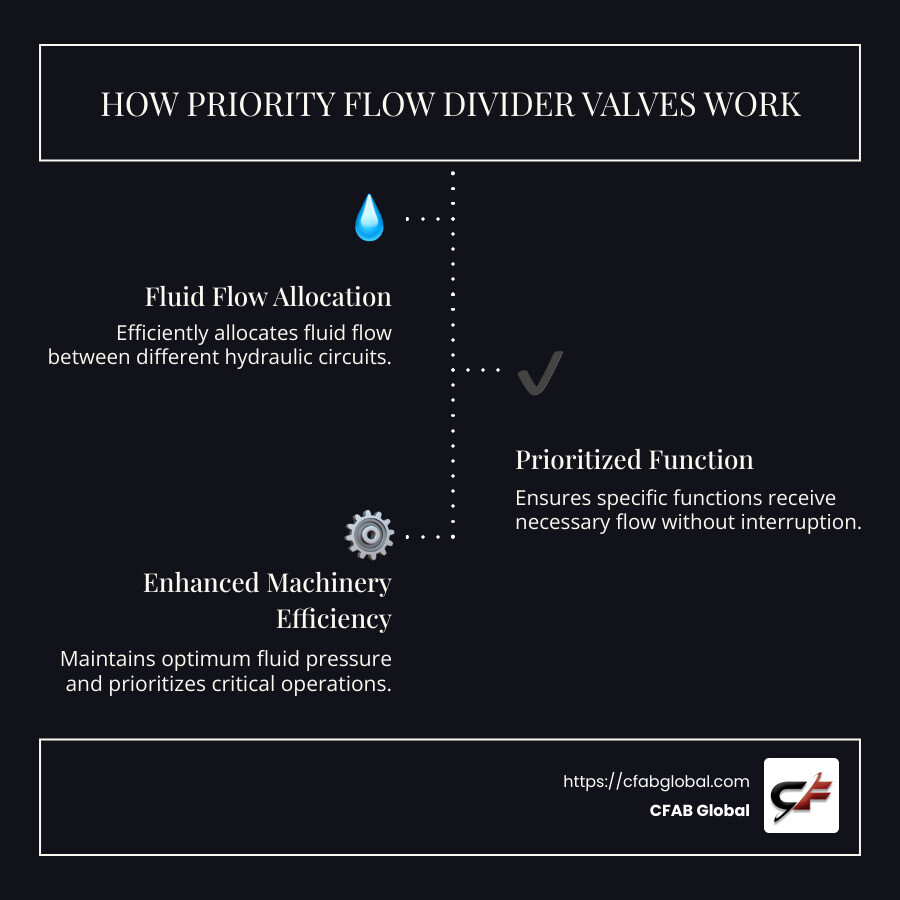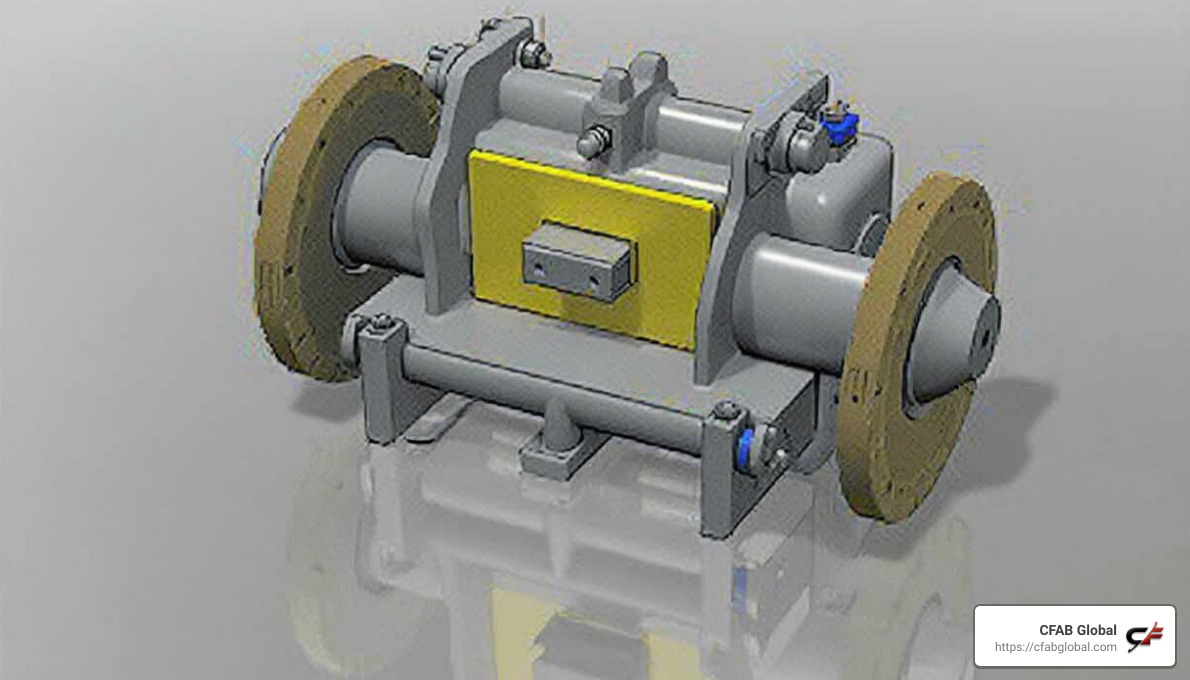A priority flow divider valve is a critical component in hydraulic systems, designed to efficiently allocate fluid flow between different hydraulic circuits. At its core, it ensures that specific functions in a machine receive the flow they need, without interrupting other processes. This makes them invaluable for machinery in industries where multiple hydraulic functions are common, like construction and agriculture.
- Key Points:
- Ensures prioritized hydraulic function.
- Simultaneous flow distribution.
- Essential in complex machinery.
Understanding how these valves work can significantly improve your machinery’s efficiency by maintaining optimum fluid pressure and prioritizing operations that are crucial to your workflow. Graco Inc. offers robust solutions for these hydraulic systems, ensuring reliable operation and extended machinery life—vital for minimizing downtime and improving productivity.
As Todd Cleppe, CEO and Co-Founder of CFAB Global, I’ve dedicated over 25 years to advancing machinery efficiency, particularly in hydraulic systems like the priority flow divider valve, ensuring businesses meet their operational demands smoothly. Let’s dig deeper into this essential technology and how it could benefit your operations.

Priority flow divider valve terms made easy:
– flow divider valve
– hydraulic priority flow divider
– pressure compensated flow divider
Understanding Priority Flow Divider Valves
A priority flow divider valve is a pivotal component in hydraulic systems. It plays a crucial role in directing hydraulic fluid to where it’s most needed. Imagine a conductor in an orchestra, ensuring each instrument gets its moment to shine. Similarly, this valve ensures priority hydraulic functions get the necessary fluid flow, while other functions continue smoothly in the background.
Hydraulic Function
Hydraulic systems rely on fluid power to perform tasks. Priority flow divider valves are essential in these systems because they manage how fluid is distributed. By controlling the flow, these valves maintain the effectiveness of different hydraulic functions.
- Key Benefits:
- Efficient Fluid Distribution: Ensures critical functions receive uninterrupted fluid supply.
- Improved System Performance: Maintains the balance between various hydraulic operations.
Load Sensing
Load sensing is a smart feature in many modern hydraulic systems. This technology allows the system to adjust fluid flow based on the demand or “load” of a particular function. When integrated with a priority flow divider valve, load sensing ensures that the priority functions operate efficiently, even when other parts of the system experience load variations.
- How It Works:
- The system detects changes in load.
- Adjusts fluid flow to maintain optimal performance.
- Prevents unnecessary strain on the system, increasing longevity.
In industries like construction and agriculture, where machinery often performs multiple tasks simultaneously, the priority flow divider valve becomes essential. It ensures that important tasks like lifting or drilling receive the necessary hydraulic power without delay.

By incorporating these valves, businesses can significantly improve their machinery’s performance. Graco Inc. provides reliable solutions for managing hydraulic functions, ensuring that your equipment runs smoothly and efficiently. This not only minimizes downtime but also improves productivity, a priority for any successful operation.
Types of Priority Flow Divider Valves
When it comes to priority flow divider valves, understanding the different types is essential for selecting the right one for your hydraulic system. Let’s break down the main types: motor type, orifice type, and progressive sequence.
Motor Type
Motor-type priority flow divider valves are designed to handle high flow rates and pressures. They are often used in systems where the priority function requires a significant amount of hydraulic power. These valves use a motor to adjust the flow rate, ensuring that the priority function always receives the necessary fluid.
- Benefits:
- Ideal for high-demand applications.
- Provides precise control over fluid distribution.
- Robust and durable for challenging environments.
Orifice Type
Orifice-type priority flow divider valves are simpler in design. They use a fixed or adjustable orifice to regulate the flow of hydraulic fluid. This type is suitable for applications where the flow rate does not need to change frequently. The orifice size determines the amount of fluid directed to the priority function.
- Benefits:
- Cost-effective solution.
- Easy to maintain and operate.
- Reliable for consistent flow requirements.
Progressive Sequence
Progressive sequence priority flow divider valves are perfect for systems that require a series of operations to occur in a specific order. These valves ensure that each function receives fluid in a set sequence, allowing for smooth operation of multiple tasks.
- Benefits:
- Facilitates complex hydraulic operations.
- Ensures smooth transitions between functions.
- Improves operational efficiency by managing sequential tasks.
Incorporating the right type of priority flow divider valve is crucial for the efficiency and performance of hydraulic systems. Whether you need precise control with a motor type, the simplicity of an orifice type, or the structured operation of a progressive sequence, there’s a solution to meet your needs.
Choosing the correct valve can significantly improve your machinery’s performance, leading to increased productivity and reduced downtime. For reliable and efficient hydraulic solutions, consider exploring options from industry leaders like Graco Inc., who offer a range of products custom to meet diverse operational requirements.
Key Features and Specifications
When selecting a priority flow divider valve, it’s important to consider key features that will ensure optimal performance in your hydraulic system. Let’s explore the essential specifications: adjustable flow, compact size, and max pressure.
Adjustable Flow
One of the standout features of priority flow divider valves is their ability to adjust the flow rate. This flexibility is vital for maintaining consistent performance across varying operational conditions. For instance, the Brand FG series allows for adjustments from 0.2 to 12 gallons per minute (gpm), ensuring that the priority port maintains the same flow setting despite changes in input flow. This adaptability not only improves system efficiency but also ensures that the priority function receives the precise amount of fluid it needs.
- Benefits:
- Customizable flow settings to match system demands.
- Improved control over hydraulic operations.
Compact Size
Space is often a premium in industrial settings, making the compact design of priority flow divider valves a significant advantage. A smaller footprint allows for easier integration into existing systems without the need for extensive modifications. The compact nature of these valves also contributes to reduced weight, which can be crucial in mobile or space-constrained applications.
- Benefits:
- Easy installation in tight spaces.
- Lightweight design for versatile applications.
Max Pressure
The maximum pressure rating of a valve is a critical specification that dictates its suitability for different applications. For example, the Muncie PFD-30 Priority Flow Divider supports a maximum pressure of 3000 PSI (207 BAR), making it robust enough for demanding environments. A high-pressure capacity ensures that the valve can handle intense operational demands without compromising on performance or safety.
- Benefits:
- Suitable for high-pressure applications.
- Reliable performance under heavy-duty conditions.
Incorporating these features into your hydraulic system can significantly improve its performance and reliability. Graco Inc. offers a range of priority flow divider valves that meet these specifications, providing solutions that are both efficient and durable. Selecting the right valve with the appropriate specifications will lead to smoother operations, increased productivity, and minimized downtime in your hydraulic systems.
How Priority Flow Divider Valves Work
Priority flow divider valves play a crucial role in hydraulic systems by managing the flow of fluid to ensure that critical components receive the necessary power. Let’s explore how these valves function through 3-way flow control, actuator priority, and load variations.
3-Way Flow Control
At the heart of a priority flow divider valve is its ability to manage flow through a 3-way control mechanism. This setup allows the valve to divide the flow from a single pump into two separate paths: one for the priority function and the other for secondary tasks. The priority path receives a consistent flow, ensuring that essential operations are never interrupted, even if the overall system demand fluctuates.
- Example:
- In a construction vehicle, the priority flow might be directed to the steering system, ensuring smooth and responsive handling, while excess flow powers auxiliary functions like the lift arm.
Actuator Priority
Actuator priority is a fundamental aspect of these valves. It ensures that the most critical operations receive the necessary hydraulic power first. This is achieved by setting the valve to prioritize flow to specific actuators, depending on the task at hand.
- Scenario:
- In a manufacturing plant, the priority flow divider valve might ensure that the hydraulic press operates continuously, while other processes, such as conveyor belts, receive fluid only when there’s excess flow.
Load Variations
Hydraulic systems often face varying loads, which can affect performance. Priority flow divider valves are designed to handle these load variations efficiently. By maintaining a steady flow to the priority function, these valves help stabilize the system, preventing any drop in performance due to changes in load.
- Real-World Application:
- In agricultural machinery, load variations occur frequently as the equipment moves through different terrains. A priority flow divider valve ensures that vital functions like harvesting mechanisms operate smoothly, regardless of the load changes.
By understanding how priority flow divider valves operate, you can better appreciate their importance in maintaining the efficiency and reliability of hydraulic systems. These valves are essential for ensuring that critical operations receive the necessary power, even in the face of changing demands.
Next, we will address some frequently asked questions about priority flow divider valves, including their functions and benefits in various applications.
Frequently Asked Questions about Priority Flow Divider Valves
What is a priority flow divider?
A priority flow divider valve is a specialized component used in hydraulic systems to manage and maintain oil flow. It ensures that critical functions receive a consistent flow of hydraulic fluid, even when the overall system demand changes. By dividing the flow from a single pump, these valves guarantee that essential operations are prioritized over less critical tasks, maintaining system efficiency and reliability.
How does a priority flow control valve work?
Priority flow control valves operate by directing hydraulic fluid through a 3-way flow control mechanism. This allows the valve to allocate the flow to different paths based on the system’s needs. The primary path, or “priority,” receives a steady flow to power crucial functions, while any excess is diverted to secondary operations or returned to the reservoir. This mechanism is essential for maintaining hydraulic function in systems with varying demands, ensuring that vital components always have the power they need to operate effectively.
What is the function of a flow divider valve?
The primary function of a flow divider valve is to provide equal flow delivery to multiple actuators in a hydraulic system. By splitting the flow from a single source, these valves help ensure that each actuator receives the necessary amount of fluid to perform its task. This is particularly important in systems with series actuators, where balanced flow is crucial for smooth and efficient operation. Flow divider valves help prevent imbalances that could lead to inefficiencies or damage to the system.
By understanding these key aspects of priority flow divider valves, you can make informed decisions about their use in your hydraulic systems, ensuring optimal performance and longevity. In the next section, we’ll explore some common misconceptions and provide tips for selecting the right valve for your needs.
Conclusion
At CFAB Global, we understand the importance of efficient machinery operations across industries. Our Machine Reliability Program is designed to ensure your equipment performs at its best. By focusing on predictive maintenance and custom solutions, we help businesses minimize downtime and maximize output.
Why choose CFAB Global? Our expertise in machinery solutions spans various sectors, from manufacturing to agriculture. We offer customized strategies that fit your unique needs, ensuring your machinery operates smoothly and efficiently. Our proactive maintenance approach prevents breakdowns before they occur, extending the lifespan of your equipment.
Our commitment to quality and reliability makes us a trusted partner in enhancing operational efficiency. Whether you’re dealing with hydraulic systems or other machinery, our solutions are designed to boost productivity and provide a better return on investment.
For more information on how CFAB Global can support your machinery needs, visit our service page.
By choosing CFAB Global, you’re investing in a future of seamless operations and sustained success.






